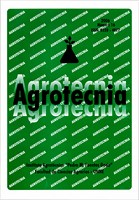Comparison of non-linear models to describe growth curves of the rough lemon root (Citrus jambhiri Lush.) under nursery conditions
DOI:
https://doi.org/10.30972/agr.347268Keywords:
Logistic model, Richards model, Monomolecular model, parameter comparison, citrusAbstract
This work aimed to find the statistical model that best describes the growth pattern of Lemon 'Rugoso' rootstock (Citrus jambhir Lusch.) in the nursery up to grafting diameter. Thus, the sowing was carried out in seedlings. 45 days after emerging, the seedlings were transplanted to 5 L pots with a substrate consisting of rice husks (40%), soil (40%), and commercial substrate (20%). Growth variables were evaluated every 30 days. For aerial growth, the following were quantified: neck diameter (DC), number of leaves (CH), stem length (LT), fresh mass of the stem (MFTa), fresh mass of leaves (MFH), dry mass of the stem (MSTa), dry mass of leaves (MSH). Also, root growth through root length (LR), fresh (MFR) and dry root mass (MSR), and total variables: total fresh mass (MFTotal), total dry mass (MSTotal), and full length (LT). To model growth curves, Logistic, Gompertz, and Monomolecular models were tested. The Gompertz model best fitted the rootstock growth over time for the aerial growth variables (except the number of leaves) and for the total variables (except the total length), while the Logistic model was the one that best adjusted the growth of the rootstock based on the time for the root growth variables. It was also suitable for the variables number of leaves and total length due to it presented a lower residual mean square of the error compared to the Logistic, Richards, and Monomolecular models.
Downloads
Published
How to Cite
Issue
Section
License

This work is licensed under a Creative Commons Attribution-NonCommercial-ShareAlike 4.0 International License.



